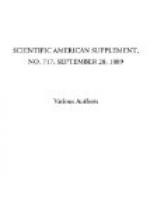Sulphur chloride gives a perfectly white product with the fresh oil, but, when oxidized, the product is very dark, almost black. The iodine absorption of the fresh oil thus obtained is very high, but falls rapidly by oxidation or blowing. A curious fact has been disclosed with reference to the oxidation of this and similar oils. If such an oil be mixed with lard oil, olive oil, or sperm oil, it thickens by oxidation, but is perfectly soluble. Such a mixture is largely used in weaving or spinning. Commercial samples of linseed oil, when cold-drawn, have a much higher iodine absorption, probably due to the same cause. Oils extracted by CS2 are very much higher than the same oils, especially if hot-pressed.—Chem. News.
* * * * *
THE PYRO DEVELOPER WITH METABISULPHITE OF POTASH.
By Dr. J. M. EDER.
Lately I called attention to the metabisulphite of potassium as an addition to the pyro solution for development, and can give now some of my experiences with this salt.
The metabisulphite of potassium, which was introduced into the market by Dr. Schuchardt, and whose correct analysis is not known yet, is a white crystal, which in a solid condition, as well as in an aqueous solution, has a strong smell of sulphurous acid. An aqueous 2 per cent. solution of this salt dissolves pyrogallic acid to a weak yellowish color, being distinguished from the more light brown solution of sulphite of soda and pyro. The solution kept very well for four weeks in half-filled bottles, and showed a better preservation than the usual solution of pyro and sulphite of soda. More than 2 per cent. of the metabisulphite of potassium is without any advantage. If this solution is mixed with soda, a picture will develop rapidly, but the same will show a strongly yellow coloration in the gelatine film. Sulphite of soda has to be added to the soda solution to obtain an agreeable brownish or black tone in the negatives.
If the contents of metabisulphite and pyro-soda developer are increased, it will act very slowly; larger quantities of the metabisulphite of potassium, therefore, act like a strong retarder. In small quantities there is no injurious retarding action, but it will have the effect that the plates obtain very clear shadows in this developer, and that the picture appears slower, and will strengthen more slowly. The strongly retarding action of larger quantities of metabisulphite might be accounted for in that the bisulphite will give, with the carbonate of soda, monosulphite and soda bicarbonate, which latter is not a strong enough alkali to develop the bromide of silver strongly with pyro. An increase of soda compensates this retarding action of the metabisulphite of potassium.
Good results were obtained by me with this salt after several tests, by producing the following solutions:
A.




